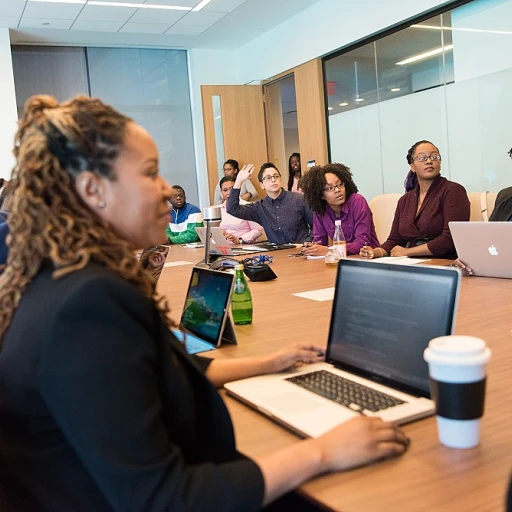
Recognizing the Signs of Disengagement
Identifying Early Indicators of Employee Disengagement
Recognizing the signs of disengagement within a team is critical for maintaining a healthy professional environment. Disengagement can manifest subtly, yet its presence can disrupt team dynamics and overall productivity. Disengagement often stems from an employee's diminished interest in work-related activities. You may notice a decline in participation during meetings or a lack of enthusiasm in collaborative projects. Communication stalls, and employees might become less responsive to emails or informal discussions over coffee. It's essential to consider whether these signs of disengagement are linked to conflicts of interest. Professional conflicts can leave team members feeling trapped or unable to make autonomous decisions, often leading to a crossword of emotions. Understanding these underlying issues can provide answers to why an employee has become distant or withdrawn. Students of organizational behavior might liken this to a challenging letter in a crossword puzzle—where each clue provides insightful answers to solve the larger picture. By leveraging professional insights into these seemingly unrelated clues, leaders can begin to address the root causes of disengagement before they proliferate. The New York Times (NYT), known for its crossword puzzles, illustrates well how each clue leads to a comprehensive understanding. In a similar vein, leadership should strive to answer the why behind disengagement, piecing together clues to craft effective strategies for re-engaging employees and fostering a positive work culture. For additional insights on recognizing such patterns and how they impact organizational dynamics, consider exploring the concept of adverse impact in HR.Common Causes of Conflicts of Interest
Identifying the Roots of Conflict
Conflicts of interest in the workplace can often be subtle, yet they have a profound impact on employee disengagement. Recognizing these conflicts is crucial for maintaining a healthy work environment. These conflicts arise when personal interests clash with professional responsibilities, creating a situation where decision-making becomes compromised. Understanding these dynamics is key to addressing the issue effectively.
Common Scenarios Leading to Conflicts
Several scenarios can lead to conflicts of interest, each with its own set of challenges:
- Personal Relationships: When team members have personal relationships, it can lead to favoritism or perceived bias, affecting team dynamics and engagement.
- Financial Interests: Employees with financial stakes in competitors or suppliers may face conflicts that influence their professional decisions.
- Dual Roles: Holding multiple roles within an organization can create conflicting priorities, leading to disengagement.
Communication and Transparency
Effective communication is essential in mitigating these conflicts. Open dialogue about potential conflicts and clear policies can help in providing answers to disengagement issues. Encouraging transparency allows employees to voice concerns and seek guidance, reducing the likelihood of conflicts escalating.
Learning from Word Games
Interestingly, the process of solving crossword puzzles, like those in the New York Times, can offer insights into conflict resolution. Just as crossword clues require careful analysis and understanding, so do conflicts of interest. By approaching these issues with a strategic mindset, organizations can find effective answers to disengagement challenges.
Impact on Organizational Culture
How Conflict of Interest Can Erode the Foundation of Workplace Culture
Understanding the detrimental effects conflicts of interest have on organizational culture is essential. Divergent interests among employees, if not managed properly, can lead to significant disengagement. Employee disengagement signifies a lack of enthusiasm and connection to the work or the organization. Just like attempting to solve a difficult crossword puzzle where the answer seems elusive, employees might find themselves puzzled by situations where their personal or professional interests conflict with organizational goals. To understand how conflicts of interest manifest, consider these points:- Erosion of Trust: Trust forms the bedrock of any vibrant workplace. When team members sense favoritism or perceive unfair advantages, trust begins to wither away, similarly to a letter left out of a crossword clue that disrupts the entire puzzle. This breakdown in trust can lead to disengagement, with employees feeling disillusioned and unsupported.
- Damaged Team Dynamics: Conflicts can create rifts within teams. As members grapple with conflicting interests, communication suffers, and collaboration dwindles. Just as in a crossword where mismatched words lead to incorrect answers, conflicting interests can disrupt the harmony needed for professional synergy.
- Reduced Transparency: When answers to ethical concerns are shrouded in opacity, not unlike a frustrating nyt crossword clue, employee morale drops. The absence of transparent disclosure on conflict of interest issues suggests a lack of organizational integrity.
- Increased Decision-Making Challenges: Decision-making can become tainted when interest entails conflicting values or goals. Employees might feel that their work decisions are coerced or based on incomplete information, much like solving a sea crossword with missing clues.
Strategies for Mitigating Conflicts of Interest
Implementing Communication Channels
One of the essential strategies to resolve conflicts of interest and disengagement is to establish clear communication channels within the workplace. When team members feel free to express their concerns, there's a reduced risk of issues escalating into larger problems. Encouraging open dialogues ensures that any potential conflicts are addressed before they can impact productivity.
Promoting Transparency
Another effective strategy is to promote transparency around decision-making processes. By making organizational decisions visible, employees can better understand the company's direction and goals. When policies and professional expectations are clearly laid out, it helps in resolving any interest disputes that might arise, leading to fewer instances of disengagement.
Developing Conflict Resolution Protocols
Having well-defined conflict resolution protocols is crucial in managing potential conflicts that could lead to disengagement. These protocols serve as clues providing answers to team members on how to handle disagreements, ensuring a harmonious work environment. It’s essential for organizations to regularly review and update these protocols to align with the evolving work culture.
Investing in Training and Development
Providing professional learning opportunities is an effective way to prevent disengagement due to conflicts. Training sessions both equip employees with better conflict resolution skills and promote interest in their roles. By focusing on these areas, companies can develop a knowledgeable workforce capable of mitigating disengagement conflict. Programs aimed at improving communication and problem-solving can enhance team cohesion, crucial for maintaining engagement.
Role of Leadership in Addressing Disengagement
The Integral Role of Leadership in Promoting Engagement
When it comes to maintaining a professional work environment, leadership plays a pivotal role in addressing employee disengagement stemming from conflicts of interest. It might seem like a crossword clue to decipher the intricate dynamics at play, but the answer often lies within proactive and engaged leadership.
Leaders serve as role models, setting the tone for communication, decision-making, and conflict resolution strategies. By ensuring open, transparent communication channels, leaders can alleviate misunderstandings that might otherwise lead to conflicts. For instance, if team members feel their voices are heard and their concerns addressed, it can foster a culture of mutual trust and understanding.
Furthermore, leadership must actively involve itself in identifying potential areas of conflict interest before they escalate into serious disengagement issues. A good leader recognizes the subtle clues of disengagement—similar to piecing together a New York Times crossword. Once identified, addressing these issues promptly can transform potential disengagement into productive professional interest.
Leadership should also focus on continuous learning and development for their entire team. Encouraging an environment where team members, including students or juniors, can learn how to navigate workplace dynamics effectively will only enhance the overall organizational culture.
In today’s fast-paced work environment, addressing conflicts of interest swiftly and efficiently is vital. As demonstrated in various studies and articles, such as in the Mastering Target Account Selling in Human Resources Data, effective leadership is key to unlocking the potential of resolving these conflicts. Leaders who prioritize understanding and mitigating interest-based conflicts lay the groundwork for an engaging and thriving organizational culture.
Leveraging Data to Understand Disengagement
Utilizing Data Insights to Decode Disengagement Patterns
In the ever-evolving workspace, understanding employee disengagement can be likened to solving a complex crossword puzzle. Each clue provides insight into potential answers for the root causes of disengagement stemming from conflicts of interest in the professional environment. By leveraging data, organizations can go beyond surface-level observations to uncover deeper issues that affect team dynamics and overall performance.
Data-driven strategies empower decision-makers to analyze communication patterns, interest conflicts, and disengagement clues that may not be immediately obvious. For instance, a spike in informal team communications might suggest unresolved conflicts or lack of alignment in shared objectives, akin to finding discrepancies in crossword clues that eventually lead to the right answer.
When implementing these solutions, it is vital to consider different data points, such as feedback surveys, professional performance metrics, and even engagement scores over time. This holistic approach to comprehension helps unravel the intricate web of disengagement down to individual factors, much like how crossword enthusiasts decipher each letter to progressively form words and phrases.
An organization should also explore data storytelling to effectively communicate findings and answers to the team members. In doing so, word games and metaphorical references – like comparing employee sentiment analysis to solving a New York Times' crossword puzzle – can enhance understanding and foster learning among managers and students of HR studies alike.
Tying all this back to the broader organizational context, informed decisions based on clear data answers facilitate the implementation of targeted solutions, ranging from tailored communication strategies to fostering more inclusive work environments. This ensures that every member has a voice, ultimately easing any tension or potential conflict interest that might arise.
In conclusion, clear data insights serve not just as a clue to understanding disengagement but as a comprehensive roadmap guiding professional relationships toward harmony and productivity.












